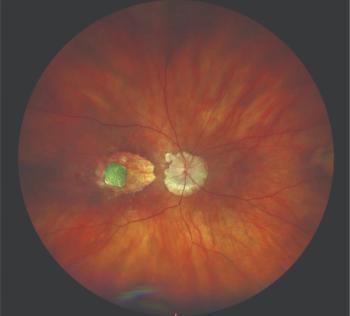
IOL power calculation for keratoconus: One-size strategy does not fit all
Analyses of predicted refractive outcomes using different IOL calculation formulas suggest possible strategies for increasing predictability in eyes with mild or moderate keratoconus.
Take-home message: Analyses of predicted refractive outcomes using different IOL calculation formulas suggest possible strategies for increasing predictability in eyes with mild or moderate keratoconus.
By Cheryl Guttman Krader; Reviewed by Wayne Bowman, MD, and David T. Truong, MD
Dallas-The challenges of
The research was undertaken by David T. Truong, MD, and Wayne Bowman, MD, Department of Ophthalmology, University of Texas Southwestern Medical School, Dallas. The review included 22 eyes of 16 patients operated on from 2010 to 2014, and the mean MRSE obtained using surgeon-specific algorithms was impressive at –0.21 D. However, the range was –6.5 D to 0.65 D.
Finding the right formula
Using clinical data to calculate predicted refraction and prediction errors using five modern lens power formulas, the investigators found the best-performing option varied depending on the preoperative corneal power.
However, none of the formulas offered good predictability in eyes with a corneal power ≥50 D.
“IOL calculation is difficult in eyes with keratoconus due to the abnormal corneal curvature, because the visual axis may not pass through the steepest part of the cornea, and since assumptions made during calculations to determine the correct IOL power are not valid in eyes with keratoconus,” said Dr. Truong, a resident in the ophthalmology department. “Our review of the literature shows remarkably little guidance on this topic.
“The findings from our analyses suggest that for eyes with a corneal power <47 D, surgeons might consider using the Holladay II formula with the double-K adjustment or the Hoffer-Q if that is not available and with a target of –1.0 D,” Dr. Truong said.
For eyes with a corneal power between 47 and 50 D, surgeons might consider using the SRK-T with a target of –1.5 D. For eyes with a higher corneal power, none of the formulas evaluated seemed to have reasonable accuracy, and “the only recommendation we can make is that surgeons should probably not use the actual corneal power,” Dr. Truong noted.
The 22 eyes in the study had a mean MRSE of –3.59 D, mean axial length of 24.21 mm, and mean corneal power (K) of 47.81 D. Applying the various formulas for all eyes pooled, the SRK-T performed the best with a mean absolute error of 0.797 D. The results with the other formulas ranged from 0.903 D with the Holladay I to 1.027 D using the Holladay II with double-K adjustment.
When the eyes were stratified by preoperative corneal power, the double-K adjustment of the Holladay II was associated with the lowest mean absolute error (0.534 D) in the subgroup of 12 eyes with a corneal power <47 D. The next best results were achieved using the Hoffer-Q (mean absolute error 0.584 D).
There were 7 eyes with a corneal power ≥47 D to 49.95 D, and in that subgroup, the lowest mean absolute error resulted using the SRK-T formula (0.956 D). For the other 4 formulas, the mean absolute error ranged from 1.196 D (Holladay II) to 1.716 D (Holladay II with double-K adjustment).
The remaining 3 eyes had a corneal power ≥55 D, and for those eyes, all formulas resulted in a larger hyperopic error (mean ≥11.5 D).
“Comparing eyes with a corneal power <47 D and >47 D, we found no significant differences between them preoperatively in patient age, BCVA, MRSE, or biometric characteristics other than corneal power-although there was a trend for the anterior chamber depth to be more smaller in eyes with the lower corneal power,” Dr. Truong said.
Prior research
Discussing published research on different methods of IOL power calculation in eyes with keratoconus, Dr. Truong cited a study by Thebpatiphat et al. that included 12 eyes [Eye Contact Lens. 2007;33:244-246]. Comparing the SRK, SRK-II, SRK-T formulas for IOL calculation, the researchers found the most accurate results were achieved using the SRK-II.
Another paper by Watson et al. evaluated results in a series of 92 eyes with mild to severe keratoconus [Br J Ophthalmol. 2014;98:361-364]. They found they had good outcomes by targeting low myopia and using the SRK-T formula with actual K values in eyes with mild or moderate keratoconus.
Consistent with the study by Drs. Truong and Bowman, use of the actual K values resulted in a larger hyperopic error in eyes with severe keratoconus (mean K >55D). Much better results were achieved in eyes where a standard K value of 43.25 D was used with a mean target refraction of –1.8 D.
However, while the mean prediction error was just +0.6 D, there was still a wide range in the outcomes.
While the double-K adjustment of the Holladay II formula has been advocated by some as a means for better sizing the keratoconic eye, there is a lack of published data pertaining to that strategy, Dr. Truong noted. Use of the SRK-T is sometimes considered since it is reputed to achieve better results than the SRK-II in myopic eyes and keratoconus is frequently associated with myopia.
David T. Truong, MD
This article was adapted from Dr. Truong’s presentation during Refractive Subspecialty Day at the 2014 meeting of the American Academy of Ophthalmology. Dr. Truong and Dr. Bowman have no relevant financial interests to disclose.
Newsletter
Don’t miss out—get Ophthalmology Times updates on the latest clinical advancements and expert interviews, straight to your inbox.





